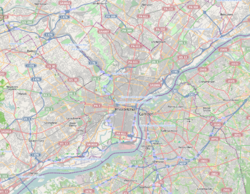Philadelphia Lazaretto
|
The Lazaretto
|
|

Lazaretto in 1936
|
|
| Location | Wanamaker Ave. and 2nd St., Essington, Pennsylvania |
|---|---|
| Coordinates | 39°51′38″N 75°18′2″W / 39.86056°N 75.30056°WCoordinates: 39°51′38″N 75°18′2″W / 39.86056°N 75.30056°W |
| Area | 10 acres (40,000 m2) |
| Built | 1799 |
| Architect | Unknown |
| Architectural style | Georgian, Federal |
| NRHP Reference # | 72001119 |
| Significant dates | |
| Added to NRHP | March 16, 1972 |
| Designated PHMC | October 25, 2008 |
 |
|
|
|
The Philadelphia Lazaretto was the first quarantine hospital in the United States, built in 1799, in Tinicum Township, Delaware County, Pennsylvania. The site was originally inhabited by the Lenni Lenape, and then the first Swedish settlers in America. Nearby Province Island was the site of the confinement of the Christian Moravian Indians who were brought there under protective custody from Lancaster, PA in 1763 when their lives were threatened by the Paxton Boys. The facility predates similar national landmarks such as Ellis Island Immigrant Hospital and Angel Island and is considered both the oldest surviving quarantine hospital and the last surviving example of its type in the United States.
The first quarantine station for the city of Philadelphia was erected in 1743 just southwest of where the Schuylkill and Delaware Rivers meet on the modern Penrose Ferry Road. A building was erected for use by sick people arriving at the port of Philadelphia and was known as the Pest House or the Old Lazaretto. The building was sold in 1802, with the proceeds used to help pay for the newly built Lazaretto, located about six miles west.
Efforts to control disease epidemics in the City of Philadelphia did not begin in earnest until after the devastating Yellow Fever Epidemic of 1793, which killed between 4,000 and 5,000 inhabitants—about one-tenth of the city's population at the time—and led the national government, which was then located there, to temporarily move out of the city. Following that epidemic, the commonwealth of Pennsylvania in 1798 created a Board of Health, controlled by the city, with the power to levy taxes for public health measures. The following year, the city Board of Health erected the Lazaretto on a 10-acre (40,000 m2)-site ten miles (16 km) south of the city on the banks of the Delaware in Tinicum Township.
...
Wikipedia



